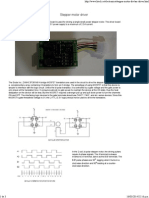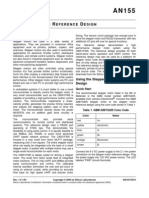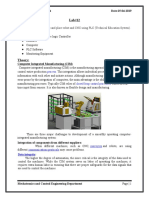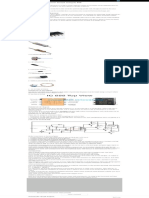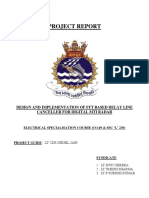Lab View Based Speed Control of DC Motor Using PID Controller-1582
Uploaded by
user01254Lab View Based Speed Control of DC Motor Using PID Controller-1582
Uploaded by
user01254International Journal of Electrical and Electronics Research ISSN 2348-6988 (online)
Vol. 3, Issue 2, pp: (293-298), Month: April - June 2015, Available at: www.researchpublish.com
LabVIEW Based Speed Control of DC Motor
Using PID Controller
Dileep Kumar1, Mazhar Hussain2, Shaurya Varendra Tyagi3, Prof. Ravi Gupta4,
Prof. Salim5
1,2,3,4,5
Electrical & Electronics Department, Krishna Institute of Engineering & Technology Ghaziabad, U.P.
Abstract: This research paper is about developing a PID (proportional-integration derivation) controller for
controlling the speed of DC motor. The software used for designing the controller is Lab VIEW 2011. The
methodology is divided in two parts first one is software development and second one is hardware implementation.
In software development calculation of DC motor transfer function and then simulation for finding out the
parameter values of PID and developing the software controller. To obtain the value for Kp, Ki and Kd ZieglerNichols Closed-Loop Method is used. Finally to interface the controller with the hardware myDAQ will be used.
After finishing both parts, speed control of DC motor can be tuned by using the PID parameter values for
analyzing of its response.
Keywords: DC motor, Lab VIEW, PID (proportional-integration derivation) controller.
I.
INTRODUCTION
Speed control of DC Motor is vital in many applications. The speed control of separately excited DC motors by PID
controller is widely used in industry. In this project, we will be controlling the speed of the DC motor using LabVIEW.
By the LabVIEW aided PID controller, the parameters are adjusted to control the motor speed. We will apply several
methods
in order to obtain best process response for tuning parameters of
PID controller. Optimum
controllability, peak overshoot, less sensitivity, optimum transients, optimum settling time will be obtained.
II.
LITERATURE REVIEW
Remya Ravindran: DC Motor control are realized with two approaches: Hardware and Software. On increasing the load
on the DC motor the voltage of the Driver circuit decreases, which leads the connected LEDs to glow showing that the
peak value of the motor RPM is reached. The output of the given system is achieved from the GUI of the LABVIEW; the
coding is done using Visual Basic.
Zhu Haishui: The controller take user input to control the speed and drive the motor at that speed free from of load. The
speed control is accomplished in an operational amplifier (op amp) circuit configured for proportional integral control.
This provides fast, smooth motor response to the user input speed and keeps the speed regulated as the motor sees with
increased load. The controller allows the motor to be driven at the maximum current load of 50A for five seconds before
shutting down the motor and requiring a user reset.
Nikunj Bhagat: The motor is modelled as a first order system and its response is studied. The speed control using PI and
PID control modes is explained and an implementation of the controller using OP-AMPs.
P. Meshram: Weighted tuning methods of a PID speed controller for separately excited Direct current motor is presented,
based on Empirical Ziegler-Nichols tuning formula and modified Ziegler-Nichol PID tuning formula. Both these methods
are compared on the basis of output response, minimum settling time, and minimum overshoot for speed demand
application of DC motor.
Page | 293
Research Publish Journals
International Journal of Electrical and Electronics Research ISSN 2348-6988 (online)
Vol. 3, Issue 2, pp: (293-298), Month: April - June 2015, Available at: www.researchpublish.com
G. Huang: LabVIEW-aided PID designed controller to monitor DC motor speed and uses the software simulation of Vis
Sim to analysis its response. To take out the analog signal through D/A converter at the same time, acquire the signal via
the NI DAQ USB-6008 card. The front panel will display the speed of DC motor on the screen. The simulation results are
quite match with the theoretical prediction for the behavior of the PID controller.
Oscar M.: The PID controller was tuned using the Ziegler-Nichols. In base of the obtained quantitative and qualitative
measures and observations, conclusion is that the fuzzy controller performance outperformed the PID controller;
moreover, the tuning process using the STA method was easier than using the Ziegler-Nichols method.
Kiran Raj S.: Interface the PMDC motor to PC using NI USB-6008 DAQ card. The state-space model of the closed loop
speed control system using LabVIEW System Identification Toolkit. The state-space model derived from this system can
be used in the model based fault detection technique for finding out the faults which could occur in the system or for
model based controls.
Kenshi M.: A specific speed control system for a small DC motor including an Ethernet network is inserted. However,
the network always has a delay time and it seems to be varied randomly on the surface. Therefore, we discuss the control
characteristics and the problems when the DC motor is driven under the system including the Ethernet network.
Especially, the relation between the distribution of delay time and control characteristics is examined at the new point of
view.
III. PROCESS OF PROJECT
1. DC MOTOR MATHEMATICAL MODEL:
We will calculate transfer function of DC motor.
Block Diagram of DC Motor
We will use PID controller for getting optimum result.
PID CONTROL THEORY and TUNING ALGORITHM:
Block diagram of PID controller
A PID controller is a feedback mechanism control loop (controller) mainly used for controlling industrial systems. A PID
controller determines an error value as the difference between a measured process variable and a desired set point. The
controller minimizes the error by adjusting the process through a manipulated variable.
Some applications use only one or two actions to provide the good system control. This is obtained by setting the other
parameters to zero. A PID controller will be called a PD, PI, I or P controller in the absence of the respective control
Page | 294
Research Publish Journals
International Journal of Electrical and Electronics Research ISSN 2348-6988 (online)
Vol. 3, Issue 2, pp: (293-298), Month: April - June 2015, Available at: www.researchpublish.com
actions. PI controllers are common, since derivative controller is sensitive to measurement noise, whereas the absence of
an integral controller may prevent the system from reaching its required value due to the control action.
PID controller with DC motor
PID controllers are tuned in terms of A, B and C. There are many methods available for tuning of PID controller. We can
use the following four methods for tuning.
Process reaction curve
Tyreus and Luyben
Ziegler Nichols method
Cohen and Coon
IV. IMPLEMENTATION OF PROJECT
Model of the DC Motor represented in the Lab VIEW Math-Script Node.
Model of the DC Motor control using PID in Block diagram window.
Simulation results
Lab VIEW VI WINDOW
Page | 295
Research Publish Journals
International Journal of Electrical and Electronics Research ISSN 2348-6988 (online)
Vol. 3, Issue 2, pp: (293-298), Month: April - June 2015, Available at: www.researchpublish.com
Transfer Function of Motor
V. SIMULATION RESULTS
Simulation Result for Kp =1, Ki =0, Kd =0
Simulation Result for Kp=0.2, Ki=0, Kd=0
Page | 296
Research Publish Journals
International Journal of Electrical and Electronics Research ISSN 2348-6988 (online)
Vol. 3, Issue 2, pp: (293-298), Month: April - June 2015, Available at: www.researchpublish.com
Simulation Result for Kp=0.4445, Ki=0,Kd=0
Page | 297
Research Publish Journals
International Journal of Electrical and Electronics Research ISSN 2348-6988 (online)
Vol. 3, Issue 2, pp: (293-298), Month: April - June 2015, Available at: www.researchpublish.com
Now, VI for calculating performance parameters is built.
Simulation Result for Kp = 0.2667, Ki=28.073684, Kd=0.000633412
REFERENCES
[1] Lab VIEW Basics I Course Manual, National Instruments, 1999.
[2] Brian R Copeland, The Design of PID Controllers using Ziegler Nichols Tuning, (March 2008)
[3] Using the Lab-VIEW PID Control Toolkit with the Lab VIEW Control Design and Simulation Module Sep 2009
[4] Control Systems Engineering, Norman Nise, Wiley Publications.
[5] Automatic Control Systems, B. C. Kuo, Prentice-Hall, Englewood Cliffs, NJ, 7th Edition, 1995.
[6] Introduction: PID Controller Design". University of Michigan.
[7] Modern Control Engineering, Ogata (5th Edition).
Page | 298
Research Publish Journals
You might also like
- Integral Cycle Speed Control of Single Phase Induction Motor.50% (2)Integral Cycle Speed Control of Single Phase Induction Motor.47 pages
- DC Motor Speed Control Using PID ControllerNo ratings yetDC Motor Speed Control Using PID Controller7 pages
- Simulation of Some Power System, Control System and Power Electronics Case Studies Using Matlab and PowerWorld SimulatorFrom EverandSimulation of Some Power System, Control System and Power Electronics Case Studies Using Matlab and PowerWorld SimulatorNo ratings yet
- TP Study On DC Motor by Using H InfinityNo ratings yetTP Study On DC Motor by Using H Infinity5 pages
- Closed Loop Control of Stepper Motor Without Position SensorNo ratings yetClosed Loop Control of Stepper Motor Without Position Sensor9 pages
- Speed Control of Separately Excited DC Motor Using Fuzzy Logic ControllerNo ratings yetSpeed Control of Separately Excited DC Motor Using Fuzzy Logic Controller6 pages
- Speed Control of DC Motor Using Fuzzy Logic Controller0% (1)Speed Control of DC Motor Using Fuzzy Logic Controller28 pages
- Control of DC Motor in Labview by Using Ni-MyrioNo ratings yetControl of DC Motor in Labview by Using Ni-Myrio4 pages
- LabVIEW Simulation Tutorial - Brushed DC MotorNo ratings yetLabVIEW Simulation Tutorial - Brushed DC Motor22 pages
- Simulation of Brushless DC Motor For Performance Analysis Using MATLAB SIMULINK EnvironmentNo ratings yetSimulation of Brushless DC Motor For Performance Analysis Using MATLAB SIMULINK Environment4 pages
- Synchronous Reluctance Motor Technology - Industrial Opprtunities, Challenges and Future DirectionNo ratings yetSynchronous Reluctance Motor Technology - Industrial Opprtunities, Challenges and Future Direction30 pages
- A Vector Control System of PMSM With The Assistance of Fuzzy PID ControllerNo ratings yetA Vector Control System of PMSM With The Assistance of Fuzzy PID Controller6 pages
- V/F Based Speed Control of Induction Motor Using Simplified Fuzzy-PI Controller100% (1)V/F Based Speed Control of Induction Motor Using Simplified Fuzzy-PI Controller6 pages
- DSGW-030 Smart Gateway S Serial-Spec v5.0No ratings yetDSGW-030 Smart Gateway S Serial-Spec v5.020 pages
- PID Controllers and Algorithms: Selection and Design Techniques Applied in Mechatronics Systems Design - Part IINo ratings yetPID Controllers and Algorithms: Selection and Design Techniques Applied in Mechatronics Systems Design - Part II13 pages
- Speed Control of DC Motor Under Varying Load Using PID Controller100% (1)Speed Control of DC Motor Under Varying Load Using PID Controller11 pages
- Wheelchair Stabilizing by Controlling The Speed Control of Its DC MotorNo ratings yetWheelchair Stabilizing by Controlling The Speed Control of Its DC Motor5 pages
- Lecture 1 2 Introduction To Vlsi and Embedded System PDFNo ratings yetLecture 1 2 Introduction To Vlsi and Embedded System PDF28 pages
- Modeling and Simulation of Reluctance Motor Using Digital ComputerNo ratings yetModeling and Simulation of Reluctance Motor Using Digital Computer5 pages
- Development of Intelligent Traffic Light Control Using Fuzzy Logic - 24 Pages0% (1)Development of Intelligent Traffic Light Control Using Fuzzy Logic - 24 Pages24 pages
- Pololu - A4988 Stepper Motor Driver CarrierNo ratings yetPololu - A4988 Stepper Motor Driver Carrier7 pages
- Review of Pole Placement & Pole Zero Cancellation Method For Tuning PID Controller of A Digital Excitation Control SystemNo ratings yetReview of Pole Placement & Pole Zero Cancellation Method For Tuning PID Controller of A Digital Excitation Control System10 pages
- Speed Control of Universal Motor Using Sniversal Bridge100% (1)Speed Control of Universal Motor Using Sniversal Bridge5 pages
- Self-Tuning Controllers Simulink LibraryNo ratings yetSelf-Tuning Controllers Simulink Library6 pages
- Class 2: Servomotors - Basics & Working: Ice 3015: Control System ComponentsNo ratings yetClass 2: Servomotors - Basics & Working: Ice 3015: Control System Components19 pages
- A Matlab / Simulink Based Tool For Power Electronic CircuitsNo ratings yetA Matlab / Simulink Based Tool For Power Electronic Circuits6 pages
- PROCESS AUTOMATION LAB Board Exam Question PaperNo ratings yetPROCESS AUTOMATION LAB Board Exam Question Paper2 pages
- Stepper Motor Driver Circuit Using IC 555 - Homemade Circuit ProjectsNo ratings yetStepper Motor Driver Circuit Using IC 555 - Homemade Circuit Projects1 page
- Design of Electrical Circuits using Engineering Software ToolsFrom EverandDesign of Electrical Circuits using Engineering Software ToolsNo ratings yet
- Model SA-10 Owner's Manual: Super Audio CD PlayerNo ratings yetModel SA-10 Owner's Manual: Super Audio CD Player46 pages
- Comparing Technology Exercises. Felipe SilvaNo ratings yetComparing Technology Exercises. Felipe Silva2 pages
- Embedded Systems - Overview - TutorialspointNo ratings yetEmbedded Systems - Overview - Tutorialspoint1 page
- Computer Networks & Internet TechnologiesNo ratings yetComputer Networks & Internet Technologies13 pages
- Understanding Y.1731 Performance MonitoringNo ratings yetUnderstanding Y.1731 Performance Monitoring6 pages
- Mazda CQ-EM4571AK: Panasonic Automotive Systems CompanyNo ratings yetMazda CQ-EM4571AK: Panasonic Automotive Systems Company39 pages
- NT00121-En-07 - Modbus Master CommunicationNo ratings yetNT00121-En-07 - Modbus Master Communication12 pages
- ENG20009 - Arduino Board Quickstart GuideNo ratings yetENG20009 - Arduino Board Quickstart Guide6 pages
- Full Factory Reset For ShoreTel IP PhoneNo ratings yetFull Factory Reset For ShoreTel IP Phone1 page
- Sunsynk ThreePhaseHI 8 12K UserManual v38 EnglishNo ratings yetSunsynk ThreePhaseHI 8 12K UserManual v38 English75 pages
- Integral Cycle Speed Control of Single Phase Induction Motor.Integral Cycle Speed Control of Single Phase Induction Motor.
- Simulation of Some Power System, Control System and Power Electronics Case Studies Using Matlab and PowerWorld SimulatorFrom EverandSimulation of Some Power System, Control System and Power Electronics Case Studies Using Matlab and PowerWorld Simulator
- Closed Loop Control of Stepper Motor Without Position SensorClosed Loop Control of Stepper Motor Without Position Sensor
- Speed Control of Separately Excited DC Motor Using Fuzzy Logic ControllerSpeed Control of Separately Excited DC Motor Using Fuzzy Logic Controller
- Speed Control of DC Motor Using Fuzzy Logic ControllerSpeed Control of DC Motor Using Fuzzy Logic Controller
- Simulation of Brushless DC Motor For Performance Analysis Using MATLAB SIMULINK EnvironmentSimulation of Brushless DC Motor For Performance Analysis Using MATLAB SIMULINK Environment
- Synchronous Reluctance Motor Technology - Industrial Opprtunities, Challenges and Future DirectionSynchronous Reluctance Motor Technology - Industrial Opprtunities, Challenges and Future Direction
- A Vector Control System of PMSM With The Assistance of Fuzzy PID ControllerA Vector Control System of PMSM With The Assistance of Fuzzy PID Controller
- V/F Based Speed Control of Induction Motor Using Simplified Fuzzy-PI ControllerV/F Based Speed Control of Induction Motor Using Simplified Fuzzy-PI Controller
- PID Controllers and Algorithms: Selection and Design Techniques Applied in Mechatronics Systems Design - Part IIPID Controllers and Algorithms: Selection and Design Techniques Applied in Mechatronics Systems Design - Part II
- Speed Control of DC Motor Under Varying Load Using PID ControllerSpeed Control of DC Motor Under Varying Load Using PID Controller
- Wheelchair Stabilizing by Controlling The Speed Control of Its DC MotorWheelchair Stabilizing by Controlling The Speed Control of Its DC Motor
- Lecture 1 2 Introduction To Vlsi and Embedded System PDFLecture 1 2 Introduction To Vlsi and Embedded System PDF
- Modeling and Simulation of Reluctance Motor Using Digital ComputerModeling and Simulation of Reluctance Motor Using Digital Computer
- Development of Intelligent Traffic Light Control Using Fuzzy Logic - 24 PagesDevelopment of Intelligent Traffic Light Control Using Fuzzy Logic - 24 Pages
- Review of Pole Placement & Pole Zero Cancellation Method For Tuning PID Controller of A Digital Excitation Control SystemReview of Pole Placement & Pole Zero Cancellation Method For Tuning PID Controller of A Digital Excitation Control System
- Speed Control of Universal Motor Using Sniversal BridgeSpeed Control of Universal Motor Using Sniversal Bridge
- Class 2: Servomotors - Basics & Working: Ice 3015: Control System ComponentsClass 2: Servomotors - Basics & Working: Ice 3015: Control System Components
- A Matlab / Simulink Based Tool For Power Electronic CircuitsA Matlab / Simulink Based Tool For Power Electronic Circuits
- Stepper Motor Driver Circuit Using IC 555 - Homemade Circuit ProjectsStepper Motor Driver Circuit Using IC 555 - Homemade Circuit Projects
- Design of Electrical Circuits using Engineering Software ToolsFrom EverandDesign of Electrical Circuits using Engineering Software Tools
- Digital Electronics 3: Finite-state MachinesFrom EverandDigital Electronics 3: Finite-state Machines
- Computer Aided Design of Electrical MachinesFrom EverandComputer Aided Design of Electrical Machines
- Mazda CQ-EM4571AK: Panasonic Automotive Systems CompanyMazda CQ-EM4571AK: Panasonic Automotive Systems Company











